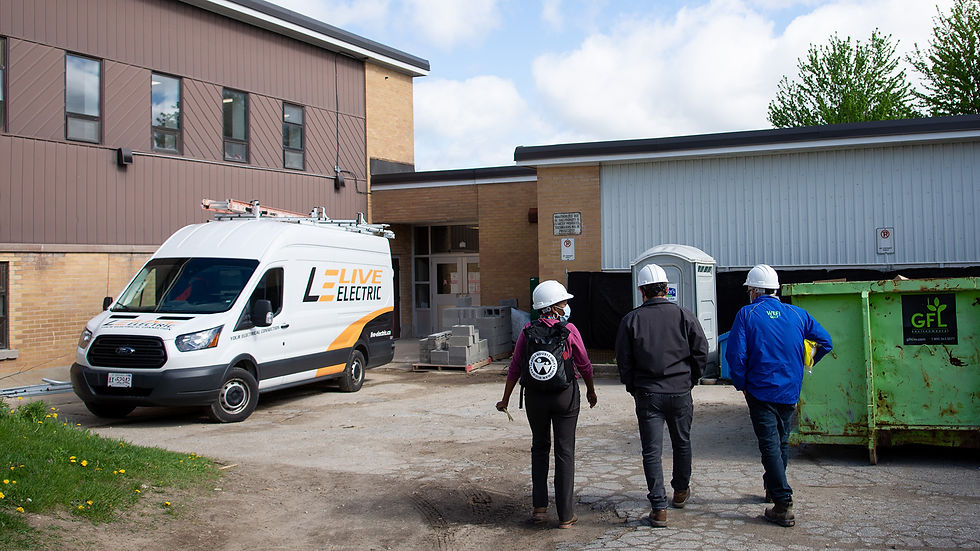Elevating Accessibility in
the WRDSB

For Mel Lavoie and the entire Facilities Services team at the Waterloo Region District School Board (WRDSB), accessibility is non-negotiable. Lavoie is a project coordinator and provided an overview of some of the innovative work undertaken to ensure WRDSB schools, offices and learning spaces are accessible for all that we serve.

“It’s just something that you have to have,” said Lavoie.
With more than 122 schools and sites, and some dating back to the 19th century, there is a broad range of buildings and spaces in the WRDSB. Ensuring that they are accessible can present a myriad of challenges, depending on a variety of factors. Lavoie explained, this variety is something he enjoys about his job, providing a new problem to solve with each project.
“I think it’s always exciting. It’s like getting a new job every year, because you do something different and it’s completely different,” said Lavoie.

Lavoie provided an overview of the project at Margaret Avenue Senior Public School in Kitchener, which saw the installation of two new elevators. Originally built in 1894, this addition was necessary to ensure that all students, staff and community members were able to access and enjoy the school space. It required an innovative solution to connect each of the floors in an accessible manner.
“If you’re in a wheelchair, you would not be able to come to this building,” said Lavoie.
The project at Margaret Avenue Senior PS was a special one for Lavoie, who attended the school as a student in 1965. It was a unique feeling to come back and help ensure the school continues to support students for decades to come.
“It’s different, going back to a school you went to, and seeing what it was like,” said Lavoie. “It just gives you that special thing.”
Silvana Hoxha is the principal at Margaret Avenue Senior PS and explained what a difference the accessibility upgrades made for the people who learn and work at the school.
“It’s really impacted everyone in the school,” said Hoxha. “Everyone was able to see and have an entry point in the school.”
Accessible buildings help to support the well-being of all students and staff who learn and work in them. This is especially important for a school, given the direct connection between well-being and academic achievement.

Looking to the near future, two accessibility-focused projects will bring elevators and other upgrades to schools in the WRDSB. Already underway, MacGregor PS in Waterloo is set to receive an elevator. A similar project at King Edward PS in Kitchener is also on the horizon.

With a cost of roughly $800,000 to $1 million to install an elevator at a school, these are serious construction projects. The work doesn’t happen overnight.
Ron Dallan is the capital projects manager for the WRDSB and explained that these projects take up to a year to complete. During that time, facilities staff work closely with school staff to minimize interruptions and allow students to continue to learn as normally as possible. For instance, at MacGregor PS, they installed a temporary, insulated wall to limit the noise coming from areas under construction.
“These aren’t like ordering a pizza,” said Dallan. “There’s a lot of planning involved. The coordinators are amazing at doing that, working with the principal at the school to make it safe.”

Accessibility goes far beyond elevators, though. Along with the installation of any elevator at a school, barrier-free washrooms are also installed on every floor reachable by that elevator. These washrooms, also known as washrooms for everyone, include features such as a power door, additional physical supports and an alarm to request assistance.

Accessible signage around the building includes raised braille, ensuring that everyone is able to navigate the school. Consideration extends to classrooms, too, where sound fields are installed so that every student in the classroom can hear the teacher just as well as those seated at the front. Sound fields are an example of an accessibility feature that is necessary for some, but good for all as it allows everyone to better understand the educator.
“All the kids can hear the same throughout the classroom. It’s projecting that sound for them,” said Lavoie.
For Lavoie and Dallan, this work is about more than just completing a construction project. It’s about building spaces that are supportive and welcoming for all students, staff and community members. Dallan explained just how much it means to the whole team.
“You’re given this privilege, to make a difference to people you’ll never even meet,” said Dallan. “It is something to be proud of.”
As a longtime skier, Lavoie has had his fair share of leg injuries and has first-hand experience with relying on supportive devices to get around. He explained how this time on crutches expanded his perspective on the importance of accessibility.

“When you go on crutches, you start understanding what accessibility means to people. Like what it truly means,” said Lavoie.
Talking to Lavoie, it’s clear that this work is more than a job to him. He has a passion for creating schools that are supportive of all.
“To have a facility that’s for everyone, that’s always motivated me,” said Lavoie. “That’s the first step, right?”
Accessibility in the WRDSB
Learn more about the WRDSB 2021-2026 Accessibility Plan


